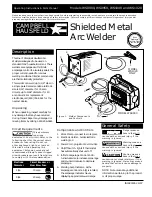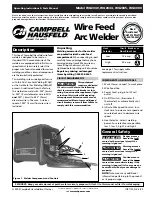
15
Duty cycle
Important!
When comparing duty-cycle data, remember that Fronius assumes an
ambient temperature of 40 °C. Even if the ambient temperature is only marginally lower,
considerably longer duty cycles are possible.
The duty cycle is stated in % and refers to a 10-minute cycle.
At the stated ambient temperature and at the stated welding amperage, uninterrupted
welding is possible for the stated %age of this 10-minute period.
For the rest of the 10-minute cycle, the power source cuts out (“Error” indicator lights
up). Once the power source has switched itself back on again, welding can be resumed
immediately.
Important!
The power source is designed so that after the appropriate pause periods,
the 10-minute cycle can be repeated an unlimited number of times.
Even at maximum welding amperage, the possible duty cycles are usually more than
sufficient, and are often prolonged in any case by:
-
the (unavoidable) need to change the electrode from time to time
-
the fact that weld-seams are not of unlimited length, and
-
the fact that more often than not, the ambient temperature will be below 40°C
anyway.
I
(A)
t
(min)
0
140
3.5
10
0
20
30
10
3,5
Fig.4 35 % duty cycle, with a welding amperage of 110 A
Example of the duty cycle stated on the
rating plate, at a welding amperage of 140
A and selected welding process “rod-
electrode welding“ (Fig.4):
- duty cycle is 35 %
- at an ambient temperature of 40 °C
- This means:
-
3.5 minutes’ welding
-
6.5 minutes’ pause
Example of the duty cycle stated on the
rating plate, at a welding amperage of 80
A and selected welding process “rod-
electrode welding“ (Fig.5):
- duty cycle is 100 % (continuous
operation)
- at an ambient temperature of 40 °C
- This means:
-
welding is possible for an unlimited
period of time
I
(A)
t
(min)
0
10
0
Fig.5
100 % duty cycle, witha welding amperage of 80 A
80
6,5
13.5
23.5
33.5
20
30
Summary of Contents for TP 1500
Page 1: ...1 Service Manual...
Page 53: ...53 Overall circuit diagram...
Page 54: ...54...
Page 114: ...114...
















































